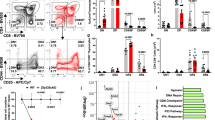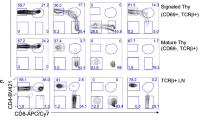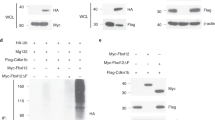Abstract
Mutation or ablation of T cell factor 1 and lymphocyte enhancer factor 1 indicated involvement of the Wnt pathway in thymocyte development. The central effector of the Wnt pathway is β-catenin, which undergoes stabilization upon binding of Wnt ligands to frizzled receptors. We report here that conditional stabilization of β-catenin in immature thymocytes resulted in the generation of single positive T cells that lacked the αβ TCR and developed in the absence of pre-TCR signaling and TCR selection. Although active β-catenin induced differentiation in the absence of TCRs, its action was associated with reduced proliferation and survival when compared to developmental changes induced by the pre-TCR or the αβ TCR.
This is a preview of subscription content, access via your institution
Access options
Subscribe to this journal
Receive 12 print issues and online access
$209.00 per year
only $17.42 per issue
Buy this article
- Purchase on Springer Link
- Instant access to full article PDF
Prices may be subject to local taxes which are calculated during checkout






Similar content being viewed by others
References
Shortman, K. & Wu, L. Early T lymphocyte progenitors. Annu. Rev. Immunol. 14, 29–47 (1996).
Moore, T. A. & Zlotnik, A. T cell lineage commitment and cytokine responses of thymic progenitors. Blood 86, 1850–1860 (1995).
Di Santo, J. P. et al. The common cytokine receptor γ chain and the pre-T cell receptor provide independent but critically overlapping signals in early α/β T cell development. J. Exp. Med. 189, 563–574 (1999).
Groettrup, M. et al. A novel disulfide-linked heterodimer on pre-T cells consists of the T cell receptor β chain and a 33 kd glycoprotein. Cell 75, 283–294 (1993).
von Boehmer, H. et al. Pleiotropic changes controlled by the pre-T cell receptor. Curr. Opin. Immunol. 11, 135–142 (1999).
von Boehmer, H. Lymphocyte survival and lineage commitment through positive selection in Great Experiments in Biology (eds. Lewin, B. and Pond, L.) at www.ergito.com (Ergito, 2001).
Schilham, M. W. et al. Critical involvement of Tcf-1 in expansion of thymocytes. J. Immunol. 161, 3984–3991 (1998).
Okamura, R. M. et al. Redundant regulation of T cell differentiation and TCRα gene expression by the transcription factors LEF-1 and TCF-1. Immunity 8, 11–20 (1998).
de Lau, W. & Clevers, H. LEF1 turns over a new leaf. Nature Genet. 28, 3–4 (2001).
Staal, F. J. et al. Wnt signaling is required for thymocyte development and activates Tcf- 1 mediated transcription. Eur. J. Immunol. 31, 285–293 (2001).
Wodarz, A. & Nusse, R. Mechanisms of Wnt signaling in development. Annu. Rev. Cell. Dev. Biol. 14, 59–88 (1998).
Matsuzawa, S. & Reed, J. C. Siah-1, SIP, and Ebi collaborate in a novel pathway for β-catenin degradation linked to p53 responses. Mol. Cell. 7, 915–926 (2001).
Liu, J. et al. Siah-1 mediates a novel β-catenin degradation pathway linking p53 to the adenomatous polyposis coli protein. Mol. Cell. 7, 927–936 (2001).
Harada, N. et al. Intestinal polyposis in mice with a dominant stable mutation of the β-catenin gene. EMBO J. 18, 5931–5942 (1999).
Shinkai, Y. et al. RAG-2-deficient mice lack mature lymphocytes owing to inability to initiate V(D)J rearrangement. Cell 68, 855–867 (1992).
Buer, J., Aifantis, I., DiSanto, J. P., Fehling, H. J. & von Boehmer, H. Role of different T cell receptors in the development of pre-T cells. J. Exp. Med. 185, 1541–1547 (1997).
Aifantis, I., Gounari, F., Scorrano, L., Borowski, C. & von Boehmer, H. Constitutive pre-TCR signaling promotes differentiation through Ca2+mobilization and activation of NF-kB and NF-AT. Nature Immunol. 2, 403–409 (2001).
Hoffman, E. S. et al. Productive T cell receptor β-chain gene rearrangement: coincident regulation of cell cycle and clonality during development in vivo. Genes Dev. 10, 948–962 (1996).
Moore, N. C., Anderson, G., Williams, G. T., Owen, J. J. & Jenkinson, E. J. Developmental regulation of bcl-2 expression in the thymus. Immunology 81, 115–119 (1994).
Newton, K., Harris, A. W. & Strasser, A. FADD/MORT1 regulates the pre-TCR checkpoint and can function as a tumour suppressor. EMBO J. 19, 931–941 (2000).
Voll, R. E. et al. NF-κB activation by the pre-T cell receptor serves as a selective survival signal in T lymphocyte development. Immunity 13, 677–689 (2000).
Maraskovsky, E. et al. Bcl-2 can rescue T lymphocyte development in interleukin-7 receptor- deficient mice but not in mutant rag-1−/− mice. Cell 89, 1011–1019 (1997).
Haks, M. C., Krimpenfort, P., van den Brakel, J. H. & Kruisbeek, A. M. Pre-TCR signaling and inactivation of p53 induces crucial cell survival pathways in pre-T cells. Immunity 11, 91–101 (1999).
Linette, G. P. et al. Bcl-2 is upregulated at the CD4+ CD8+ stage during positive selection and promotes thymocyte differentiation at several control points. Immunity 1, 197–205 (1994).
Mombaerts, P. et al. Mutations in T cell antigen receptor genes α and β block thymocyte development at different stages. Nature 360, 225–231 (1992).
Fehling, H. J., Krotkova, A., Saint-Ruf, C. & von Boehmer, H. Crucial role of the pre-T cell receptor α gene in development of α β but not γ δ T cells. Nature 375, 795–798 (1995).
Mombaerts, P. et al. RAG-1-deficient mice have no mature B and T lymphocytes. Cell 68, 869–877 (1992).
Winandy, S., Wu, L., Wang, J. H. & Georgopoulos, K. Pre-T cell receptor (TCR) and TCR-controlled checkpoints in T cell differentiation are set by Ikaros. J. Exp. Med. 190, 1039–1048 (1999).
Kabra, N. H., Kang, C., Hsing, L. C., Zhang, J. & Winoto, A. T cell-specific FADD-deficient mice: FADD is required for early T cell development. Proc. Natl Acad. Sci. USA 98, 6307–6312 (2001).
Walsh, C. M. et al. A role for FADD in T cell activation and development. Immunity 8, 439–449 (1998).
Nacht, M. et al. Mutations in the p53 and SCID genes cooperate in tumorigenesis. Genes Dev. 10, 2055–2066 (1996).
Jiang, D., Lenardo, M. J. & Zuniga-Pflucker, C. p53 prevents maturation to the CD4+CD8+ stage of thymo cyte differentiation in the absence of T cell receptor rearrangement. J. Exp. Med. 183, 1923–1928 (1996).
Nakajima, H. & Leonard, W. J. Role of Bcl-2 in α β T cell development in mice deficient in the common cytokine receptor γ-chain: the requirement for Bcl-2 differs depending on the TCR/MHC affinity. J. Immunol. 162, 782–790 (1999).
Aifantis, I. et al. On the role of the pre-T cell receptor in αβ versus γδ T lineage commitment. Immunity 9, 649–655 (1998).
Acknowledgements
We thank C. Wilson, C. Beard and S. Korsmeyer for the lck-cre mice; A. Siermann and the DFCI sorting facility for technical assistance; P. Sicinski, L. Haughn and C. Borowski for discussions and critical reading of the manuscript; and L. Holcomb for help in preparing the manuscript. F. G. and K. K. also thank Artemis for support. Supported by grants from the Ministry of Education, Science, Sports and Culture; Organization for Pharmaceutical Safety and Research, Japan; the Joint Research Fund between the University of Tokyo and Banyu Pharmaceutical Co; and NIH grants R01A145846 and R01AI47281.
Author information
Authors and Affiliations
Corresponding author
Rights and permissions
About this article
Cite this article
Gounari, F., Aifantis, I., Khazaie, K. et al. Somatic activation of β-catenin bypasses pre-TCR signaling and TCR selection in thymocyte development. Nat Immunol 2, 863–869 (2001). https://doi.org/10.1038/ni0901-863
Received:
Accepted:
Published:
Issue Date:
DOI: https://doi.org/10.1038/ni0901-863
This article is cited by
-
TCF1 in T cell immunity: a broadened frontier
Nature Reviews Immunology (2022)
-
TCF-1: a maverick in T cell development and function
Nature Immunology (2022)
-
Delayed maturation of thymic epithelium in mice with specific deletion of β-catenin gene in FoxN1 positive cells
Histochemistry and Cell Biology (2021)
-
Thymus neuroendocrine tumors with CTNNB1 gene mutations, disarrayed ß-catenin expression, and dual intra-tumor Ki-67 labeling index compartmentalization challenge the concept of secondary high-grade neuroendocrine tumor: a paradigm shift
Virchows Archiv (2017)
-
β-Catenin is required for the differentiation of iNKT2 and iNKT17 cells that augment IL-25-dependent lung inflammation
BMC Immunology (2015)



